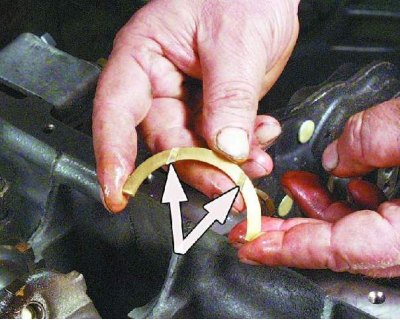
Attention! An anti-friction layer is applied on the thrust half rings from the side of the grooves. This side of the half rings should be installed to the cheeks of the crankshaft.

From the front of the bed (camshaft drive side) a steel-aluminum half ring is installed (white color), and on the other hand - cermet (yellow color).

The main bearing caps are marked in the form of notches: on the first one, on the second two, on the third three, on the fourth four, on the fifth two. On the second cover, in addition to the marks, there are two holes for attaching the oil pump receiver. The first is the cover on the drive side of the camshaft.

1. Install the liners in the bed of the main bearings. In this case, the fixing protrusion of the liner should enter the groove of the bed. In the first, second, fourth and fifth bed (counting from the camshaft drive) install liners with grooves, and in the third - without grooves.

2. Lubricate the liners with engine oil.

3. Lubricate the crankshaft journals with engine oil and place the shaft in the bed of the main bearings. In this case, the flywheel mounting flange must be located on the side of the fourth cylinder.

4. Insert two thrust half rings into the grooves of the bed of the third main bearing.

5. Rotate the half rings so that their ends are flush with the ends of the bed.
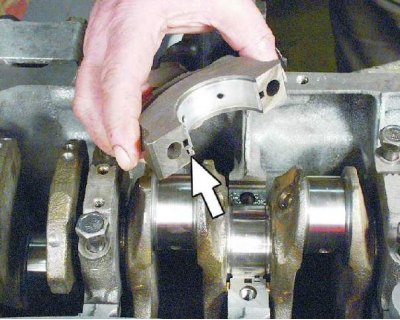
6. Insert the liners into the non-grooved liners. In this case, the fixing protrusion of the insert should enter the groove of the cover.

7. Lubricate the cover insert with engine oil. Replace the cover according to the mark.
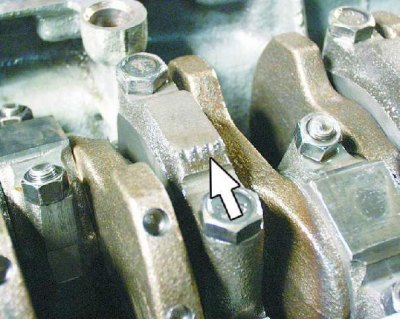
8. The cover is installed so that the mark on it is located on the side of the generator (on the left side of the engine). Install the rest of the covers in the same way according to the marks.

9. Tighten the cover bolts without tightening them.

10. Tighten the cap bolts to 69-84 Nm (6.9-8.4 kgf·m). Tighten the bolts of the third cover first, then the second and fourth, then the first and fifth. After tightening the bolts, turn the crankshaft - it should rotate easily, without jamming.

11. Using an indicator, measure the crankshaft end play. It should be within 0.06-0.26 mm. If the gap exceeds 0.26 mm, replace the thrust washers (see note 1).

Note 1. To measure the crankshaft end play, install the indicator so that its leg rests on the shaft flange. Slide the crankshaft all the way away from the indicator and set the indicator to 0. Slide the crankshaft in the opposite direction. The indicator will show the gap.
Note 2: Half-rings of nominal size are available as spare parts (thickness 2.31-2.36 mm) and increased by 0.127 mm in size (thickness 2.437-2.487 mm).
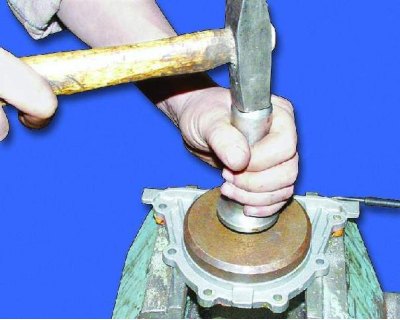
12. Using a mandrel, press the crankshaft rear oil seal into the holder until it stops.

13. Grease the holder gasket to the gland holder for ease of installation.
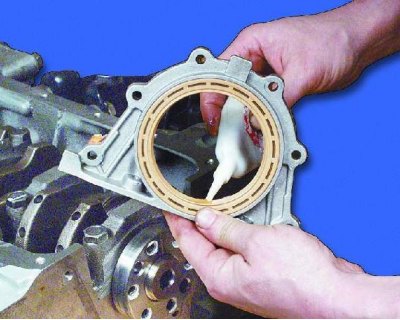
14. Lubricate the seal lip with engine oil.
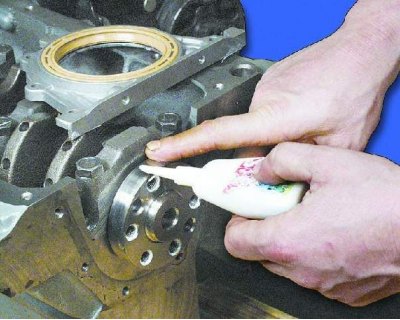
15. Lubricate the crankshaft flange with engine oil.

16. The crankshaft rear oil seal is installed in the holder using a special mandrel. In the absence of a mandrel, put the oil seal with the holder on the crankshaft flange, carefully tucking the working edge of the oil seal on the shaft flange with a pointed softwood stick.

17. Carefully slide the holder along the flange until it stops and screw on the fastening bolts.

18. Adjust the holder so that its upper plane coincides with the plane of the block.

19. Tighten the six bracket mounting bolts.

20. Press the front crankshaft oil seal into the oil pump housing using a mandrel. Lubricate the seal lip with engine oil.

21. Lubricate the oil pump gears with engine oil by pouring oil through the oil receiver hole.

22. Rotate the oil pump gears several times by the pinion lugs.

23. Rotate the oil pump drive gear to fit correctly on the crankshaft: the lugs on the drive gear must align...

24.... with flats on the crankshaft.

25. Glue the sealing gasket to the pump with grease for ease of installation.

26. The front crankshaft oil seal is installed using a special mandrel. If there is no mandrel, put the pump with the stuffing box on the crankshaft to the seat on the shaft. Then, with a pointed soft wood stick, carefully tuck the seal lip onto the shaft journal.

27. Carefully slide the oil pump along the shaft until it stops and install the mounting bolts. Adjust the position of the pump so that its top plane coincides with the plane of the block. Wrap six mounting bolts with a torque of 8.5-10.0 Nm (0.85-1.0 kgf·m).

28. Thoroughly wipe the cylinder mirrors...

29....and the crankshaft journals with a soft, lint-free cloth.

30. Lubricate the mirror of the first cylinder with engine oil.

31. Lubricate the piston insert with engine oil.

32. Lubricate the piston of the 1st cylinder with engine oil.

33. Separate the locks of the piston rings at an angle of 120°relative to each other.

34. Insert the piston assembly with the connecting rod into the mandrel and use it to install the piston into the cylinder so that the arrow on the piston crown points towards the oil pump.
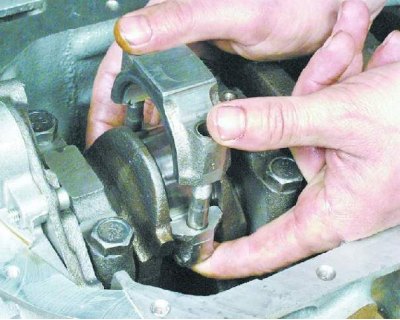
35. Install the connecting rod cap with the liner in accordance with the marking, after lubricating the liner with engine oil (see note).

Note. Connecting rod caps are installed so that the cylinder numbers on the cap and connecting rod are on the same side.
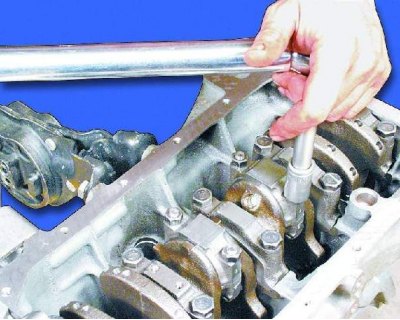
36. Tighten the two cap screws. Install the rest of the pistons in the same way.

37. Tighten the connecting rod cap nuts with a torque wrench to a torque of 44-54 Nm (4.4-5.4 kgf·m).

38. Lubricate the threads of the flywheel mounting bolts with a thin layer of sealant.

39. Install the flywheel, then the lock washer and tighten the flywheel mounting bolts (see note).

Note. Install the flywheel so that the mark on the flywheel is opposite the connecting rod cap of the fourth cylinder, since the mounting bolts are asymmetrically located.

40. Tighten the flywheel mounting bolts to 62-89 Nm (6.2-8.9 kgf·m), holding the flywheel from turning.

41. Lubricate the oil receiver sealing ring with engine oil.
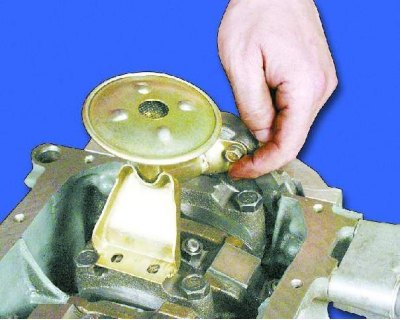
42. Install the oil pickup (see note) and tighten the bolt securing the oil receiver to the oil pump with a torque of 7.0-8.0 N·m (0.7-0.8 kgf·m).

Note. Before installation, we recommend replacing the oil receiver sealing ring.
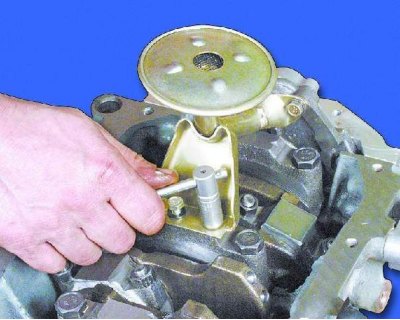
43. Tighten the two bolts securing the oil receiver to the cover of the second main bearing with a torque of 8-10 Nm (0.8-1.0 kgf·m).

44. Cut off the protruding ends of the oil seal holder and oil pump gaskets.

45. Lubricate the mating surface of the cylinder block with grease.

46. Install the oil pan seal.

47. Install the oil pan.

48. Tighten the oil sump mounting bolts to a torque of 5-8 Nm (0.5-0.8 kgf·m).
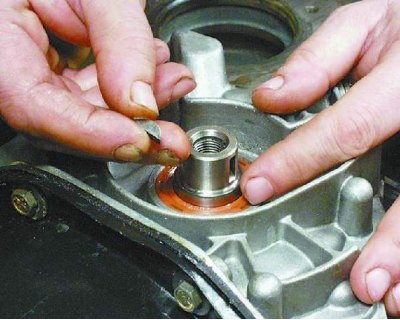
49. Install the key in the groove of the crankshaft.

50. Install the crankshaft pulley with the pin out.

51. Put the toothed belt on the crankshaft pulley.

52. Install the pulley on the crankshaft, aligning the hole in the pulley with the pin on the camshaft timing belt sprocket.

53. Torque 99.0-110.0 Nm (9.9-11.0 kgf·m) pulley bolt with washer, fixing it from turning.

54. Install the sealing gasket to the water pump and lubricate the gasket with grease.

55. Install the water pump in the cylinder block so that the factory marking of the pump is directed towards the mating plane of the cylinder block, since the mounting bolts are asymmetrically located.

56. Install the rear camshaft drive cover.

57. Wrap the four bolts securing the rear cover to the cylinder block with a torque of 7.8-8.0 Nm (0.78-0.80 kgf·m).

58. Install the driven plate into the pressure plate housing so that the less protruding part of the hub is directed towards the flywheel.

59. Insert the centering mandrel into the splines of the driven disc from the side of the diaphragm spring.

60. Install the clutch on the flywheel.

61. Tighten the six bolts securing the clutch to the flywheel evenly diagonally to a torque of 19.0-31.0 Nm (1.9-3.1 kgf·m). We recommend that you replace the mounting bolts during assembly.
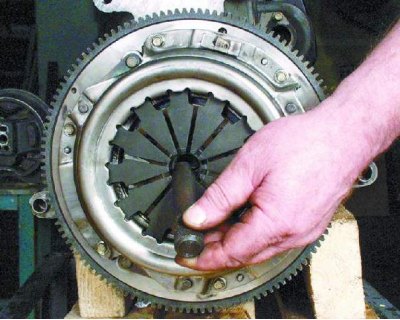
62. Remove the centering mandrel.
